You are here:
Home > Awareness Facts
Awareness Facts
There is a dire need of awareness in the people regarding the food eaten from the market. Outside food can prove fatal if not prepared properly or handled unhygienically. It can be as much dangerous as delectable it looks when presented. Public should be informed about all the safety norms and the conditions that make food safe.
Food from the Street Vendors
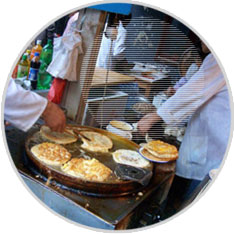
People easily get tempted by the food offered by street vendors due the unique ways in which it is prepared and its touch of spices. One can’t really trust them as almost all of them are unaware about the safety of food and the repercussions of it being unhealthy.
There are a few pointers that one can keep in mind while eating from the vendors:
- Check out the overall cleanliness of the stall or kiosk in terms of its hygienic levels and the surroundings.
- Notice the physical appearance of the vendor in terms of his nails being cut, hair being tied and the cloth being used while the food preparation.
- Find out the source of water being used in the food.
- Check out if the utensils, vegetables or fruits and the equipments being used are being washed properly or kept clean.
All in all it is up to the people to be knowledgeable in choosing the vendors while buying food.
Indian Food, from Farm to the Tables
Food can become contaminated at many levels. There are many factors that make people more susceptible than others to the dangers caused by unsafe food. It is of utmost importance that people should understand that the food passes through several levels till it reaches them for consumption. At all these levels there can be some amount of negligence on the part of the food handlers. If at every step, safety standards are held high and followed, there would be a tremendous decrease in the food borne illnesses. One needs to be aware of all the safety aspects of food to avoid any risk to the health.

People should ensure that the food we eat is free from food-borne hazards such as pesticides and industrial chemicals, unwanted bacteria and contaminants at all the levels. Each and every link needs to be strengthened starting from the way it is grown, collected, processed, packaged, sold and consumed. One should know what he/she is eating and where it comes from.
Hygiene on the farm such as the health of the animal, food fed and its management should be taken care of to avoid contamination of animal products and risks of diseases that can be transmitted to humans. At the farm level, all the safety norms should be followed strictly during soil and water management, crop and animal production, storage, processing and waste disposal.
From the farms, food enters the wholesale markets. The places where food is stored and its surrounding areas at this level should be clean and insects free. There should be proper drainage system for the disposal of the waste, which if not taken care of, can be life threatening. The same practices should be followed at the retails outlets and on to the consumers. Thereon the consumers need to be alert regarding the further usage of the food bought from the market. Washing it properly, chopping it on the clean surface, cooking at the right temperature, serving it with clean hands and finally storing it or reheating it at the right temperature.
Weak links especially near the beginning can make the whole food chain deteriorate. Consumers should be given training and education on the safe storage, preparation and consumption of food. From the food producers and processors to the wholesalers, retailers and the consumers, the responsibility of passing on safe food needs to be shared and advocated.
Mid-Day Meal in Schools
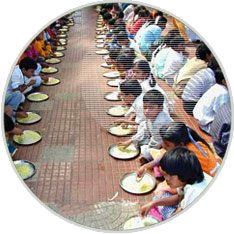
The Mid-Day Meal is a programme that has been developed to feed primary and upper primary school children. It reaches out to about 12 crore children in different schools/EGS centres across the country. This makes it extremely important for the students who consume this food, the teachers or officials who prepare and serve it as well as the parents to understand the criterion of safe food.
The purpose of this scheme is to enhance the enrollment, retention, attendance and to improve the nutritional levels among the children. The hygiene of the food being prepared for the students should be very well maintained. From the buying of the ingredients, raw food, its transportation, its storage, its preparation into a full cooked meal to its serving, at all the steps, safety measures should be implemented sternly. Children as well should be taught about judging the condition of the food before eating and washing their hands properly before and after.
Those cooking methods should be used which preserve and enhance the nutritional content of the food. There should be periodic checks at the agencies or caterers under contract to prepare the food.The utensils used for preparing the food as well as the ones in which it is served need to be washed properly. Kitchens should be kept clean and tidy with no litter around. The cooks need to keep themselves tidy and wash their hands frequently.
Mid-Day meal is a very beneficial programme and has proved its worth by feeding innumerable students across the country. Since a large number of students are being fed, productive steps need to be taken to ensure their good health which is the prime motive of the move. Health of crores of students would be at stake if something goes wrong in terms of the food hygiene. Spread of awareness among all the students through their parents and the teachers is very crucial. They should be made capable enough of knowing the quality and the hygiene of the food they are eating. Precautionary steps are always better than the cure.
Safety of Train Food
How safe do you think is the train food? There are so many places where a person can go wrong while eating. When travelling in a train, there is hardly any percentage of people who actually bother themselves with finding out the quality of food or water being offered. Ignorance of such kind can prove fatal. One needs to be aware since the train authorities are supposed to serve food to innumerable people and keeping a tab on its hygiene can be cumbersome and ignored at times.
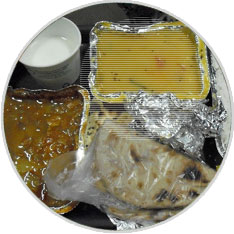
People need to protect themselves against bacteria, fungi, viruses, insects and pests who can be directly harmful or carriers of diseases. The train authorities should supervise the food handling facilities to keep their places hygienic and follow sanitary practices. Those who travel frequently need to be aware about the quality and unsafe nature of foods prepared and served at rail stations. There should be a quality control system that is followed strictly by the officials incharge.
The way food is cooked, physical cleanliness of the people preparing it, surrounding hygiene, purity of water offered to the passengers, these are the issues people need to take care of when travelling. Checking out all this may sound a bit awkward but if the health is at stake, one needs to act extra cautious.
Not only in the train but the vendors selling food at the railway stations prepare their items at smelly places with no sanitary arrangement or hygienic measures.Even the utensils in which they serve are not cleaned properly. There are also instances where soft drinks are offered in used plastic bottles which the consumer never realizes while buying. These are the things people need to notice while eating or drinking especially at the railway stations. Such unsafe practices can cause diseases like typhoid, hepatitis, diarrhea and different kinds of infections.
Railways too should follow the
HACCP (Hazard Analysis Critical Control Points) standards sternly just like the airline authorities. The application of
HACCP by the airlines involves training the supervisors and people directly involved in preparingmeals. Strict standards for food product acceptance are used. Sickness and discomfort can be averted to a large extent if the railways start adopting food safety measures with productive efforts. Implementation of
HACCP standards allows the food handlers to put their food safety training into practice. At the same time the passengers should be informed enough to verify the quality of food and drinks being offered to them. This is an effective strategy to question the authorities in case of unsafe food being offered and to help reduce the dangers to health of a lot of people concerned.
'Drink and Drive’ Questioned
How safe are people when they walk on the roads? In the blink of an eye one can loose his/her life. A number of such incidents are caused due to drunken drivers. Their intoxication can cause havoc in the lives of so many people. They don’t do it deliberately but it is their fault. No control over the quantity of drinks taken during one occasion can result in disastrous situations.
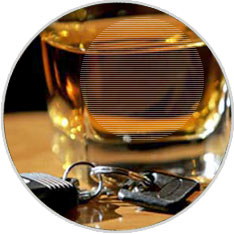
Driving while either intoxicated or drunk leads to car accidents, highway injuries and vehicular deaths. Such incidents can be prevented. It’s not just the drunken driver who’s at fault but the bar tender or the host who served him/her more than required quantity is also equally responsible. In this case the best preventive measure is to be aware while travelling. Each person should take his/her responsibility and walk or drive cautiously.
Walk on the foot paths and stay alert for the rash drivers who might just drive over you. Strictly avoid drinking and driving and don't ride with anyone who is drunk or had more than required. Always use a safety seat belt and avoid travelling after midnight especially on Fridays and Saturday. Try and Choose vehicles with airbags.Know your limit when you are drinking and drink slowly instead of gulping it.
Even the bar tenders should be qualified through a course on safe drinking such as
Safe Serve. These courses train them on judging what is good and what is not for the people who drink. They get to know about the appropriate quantity to be served to one person and other basic facts related to it. Well trained bar tenders or hosts always disapprove of excessive alcohol consumption. They insist on calling cabs for the people who are drunk or request their non drunk friends to drive for them.
There should be Strict enforcement of Motor Vehicle Act on drunken driving.Overall it is everyone who is responsible for drunken driving incidents. Those who drink uncontrollably. Those who serve irresponsibly. Those who don’t drink and also don’t even stop others from doing it more than they can take it. It is important for all to be aware about facts on consuming alcohol and its connected issues. Courses like safeserve have been designed to serve this purpose and bring home ‘safety’.
Many waiters carry germs on hands: Study
Pushpa Narayan, TNN | Aug 3, 2012, 05.26AM IST
The meal that the waiter has served you appears to be perfect. It looks good, smells great and has just the right quantities of protein, carbohydrates and vitamins. But zoom in at a microscopic level and you'd probably see that it also contains the most vile-looking and dangerous germs and bacteria like
Escherichia coli (E. coli) and amoebic cysts.
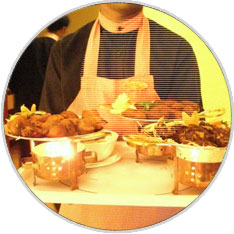
Not having hair or grime on your plate does not mean that the food served at a restaurant or roadside eatery is safe. A study shows that the hands of many chefs and waiters in the city are infested with deadly micro-organisms.
The results of the study by Indian Public Health Association have come as a shocker to people who eat out as well as doctors and health department officials. Researchers found E. coli on the hands of nearly
11.2%of the people who handle food in five star hotels. In smaller restaurants,
47% of chefs and waiters had the bacterium, which can cause serious food poisoning, on their hands. The figure rises to
84.7% in roadside eateries.
Researchers found amoebic cysts on the handsof 11.2% of waiters in roadside eateries. These cysts can cause forms of amoebiasis, from dysentery to amoebic liver abscess, the third most common cause of death (after schistosomiasis and malaria ) from parasitic infections.
What makes eating at roadside kiosks more dangerous is that these units do not follow hygienic practices and have unclean cooking practices. Eateries are often located near open drains or garbage bins. People in the city are also extremely vulnerable to food poisoning.
It is an extremely scary situation,said IPHA state president Dr. S Elango, who led the study.
"We did not know these dangers existed before the study" he said. "Food inspectors often test food quality but rarely check health and hygiene of people who handle food." The situation could be even worse, he said. "We don't know if there are other, more serious health risks because our study covered a limited number of disease causing micro-organisms," he said.
Dr. Elango'steam surveyed 250 restaurants and eateries over six months and checked the hands of 1,000 people who handled food. The subjects' hands were dipped in distilled water that was then tested in labs. The tests showed that the water contained E. coli and several other dangerous micro-organisms.
Scientists in the UK and France are now finding that lack of food safety measures could lead to the growth of superbugs that are resistant to antibiotics. Across the globe, experts have called on health officials to step up monitoring and stop superbugs likes almonella and typhimurium from spreading globally.
City health officer B Kuganatham estimates that at least 65 lakh people in Chennaieat or drink in hotels or eateries at least once every day. The trade licences for hotels and eateries are issued by the State Food and Drug Safety Authority as per the provisions of theFood Safety Act.
The law mandates hygienic practices for food handlers — including regular washing of hands with soap, use of disposable gloves, hair covers and clean clothes. A senior member of the city's hotel owner's association said many restaurants do not follow the prescribed norms. "I work in a five star restaurant and we have very stringent rules," a chef said. "But workers in our kitchens rarely wear gloves or follow other protocol." Health officials said they often come across breaches of hygiene rules.
Senior surgical gastroenterologist Dr. S.M. Chandramohan said more than two thirds of his patients with food poisoning or stomach infections had been regularly eating out. Symptoms of stomach infections show up within minutes in some cases and sometimes take days.
How to prevent food borne disease for travellers
Trina Remedios, Health Me Up | Aug 1, 2012, 12.52PM IST
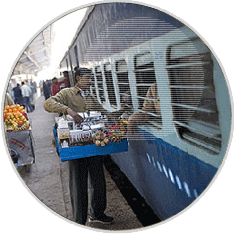
When we travel we want to try out street food and experience the local cuisine. This makes travellers prone to food borne diseases.
But there are a few secrets that you may employ to stay healthy and cheerful while you take your much needed break. To help you enjoy your vacation there are few rules you can follow to stay away from food borne diseases. We list them out for you
Traveller's Diarrhea
What is the first thing that comes to mind when you think of food borne disease for travelers? Diarrhea is at the top of the list, hence it is important to understand the term Travellers' Diarrhea.
'Traveller's Diarrhea (TD) is the most predictable travel-related illness. Attack rates range from 30% to 70% of travelers, depending on the destination. Traditionally, it was thought that TD could be prevented by following simple recommendations such as "boil it, peel, it, or forget it," but studies have found that people who follow these rules still fall ill. Poor hygiene practice in local restaurants is likely the largest contributor to the risk for TD.'
Avoid drinking tap water
This is the most common way food borne diseases spread. Avoid foods like pani puri or gol guppas that utilise tap water that is not boiled and treated. The food and juices may be delicious, but the after-effects of such food will leave you with food poisoning or a chronic case of diarrhea. All you need is a small amount of contaminated water to leave you writhing in pain.
How do you quench your thirst while traveling?
If tap water is out of the question, how do you quench your thirst? Your options lie in packaged bottle water, tetra packed juices and bottled juices from popular companies.
Besides that you can warm up to the amazing chai prepared by every stall owner in Asian city streets and highways. Remember, if the beverage is prepared with boiling water you are safe.
Another option for quenching your thirst is using water-purifying tablets or drops. This can eliminate several germs present in the water. This is also a popular method of making water drinkable when out on nature tourist trails in places that have rivers and streams, but no vendor stores.
Are raw vegetables and fruits healthy if you're travelling?
Only if you are consuming vegetables and fruits in certifiably hygienic restaurants. If it's the monsoon, especially in a developing country, completely avoid raw vegetables and fruits. Rains, poor sanitation and bacteria should not be mixed together as the results can be drastic.
Unless the vegetables and fruits are thoroughly washed, cleaned and cooked you will be at risk of catching a food borne disease. Also, if eating street-food in countries that don't monitor street food safety, refrain from consuming raw meat, food that is left in the open for a long time and food that should be refrigerated. These steps will help you prevent food borne diseases.
Tips for a healthy traveller in not-so-healthy settings:
- Check the surrounding of the restaurant or the stall.
- If the food uses uncooked eggs or milk and it has been left out for a long duration, it would be wise not to consume it. These ingredients needs proper refrigeration and should not be kept at room temperature.
- Drink plenty of water
- If you are not content with the hygiene, opt for packaged ingredients and juices.
- Eat food that is properly cooked
- Opt for fruits like banana that is covered with a thick skin that can be peeled.
- Opt for dairy that has been pasteurized
Kitchen tricks to expose food adulteration
Divashri Sinha, Mumbai Mirror | May 30, 2012, 12.00AM IST
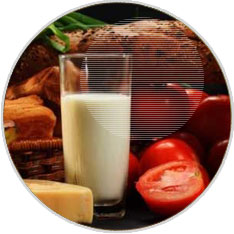 You can try these kitchen tricks to expose adulteration in your everyday ingredients
You can try these kitchen tricks to expose adulteration in your everyday ingredients.
In a country where official systems set for food safety and prevention are constantly outdone by a booming adulteration business, the onus of safeguarding one's family against contaminaed food, unfortunately falls on citizens themselves.
From loose packed ground spices, to wet produce such as milk, khoya, paneer, to dry spices and grains, almost everything you can buy has a potential of being adulterated, if purchased from an unauthorized vendor in a box unmarked and tested by either Agmark or ISI. While some of these could be less harmful, such as water or bran, chemicals and colouring agents such as Metanil Yellow, Lead Chromate, Sudan Red III, are known to be carcinogenic.
The chairman of the Consumer Guidence Society of India, Dr. Sitaram Dixit lists a few commonly used food items, and suggests simple home tests to check for their most common adulterants. In case the test asks for the presence of an acid, you could use common toilet-cleaning acid, or easily found citric acid or even lemon juice.
| Food Item |
Adulterant |
Test |
Harmful Effects |
| Turmeric, Dals and Pulses such as Moong or Channa |
Metanil Yellow and Kesari Dal (Added to enhance the yellow colour of a food substance) |
Dissolve half a spoon full of besan or turmeric powder in 20 ml of lukewarm water. Add a few drops of hydrochloric acid or any commonly available acid at home. If the water turns pink, violet or purple, it shows the presence of Metanil yellow. |
It's highly carcinogenic and if consumed over a continuous period of time it can also cause stomach disorders. |
| Green Chillies, Green Peas and other Vegetables |
Malachite Green (To accentuate the bright, glowing green colour of the vegetable) |
Take a small portion of the sample and place it over a moistened white blotting paper. Coloured impressions on the blotting paper indicate the presence of Malachite green. |
It's a coloured dye that has proven to be carcinogenic for humans if consumed over a long period of time. |
| Mustard Seeds and Mustard Oil |
Argemone seeds (used to add bulk and weight) |
When pressed or crushed, argemone seeds are white inside and have a rough outer surface whereas mustard seeds are smooth on the outside and are yellow on the inside. |
The consumption of these could cause epidemic dropsy and severe glaucoma. Young children and senior citizens with poor immunity are more susceptible this. |
| Paneer, Khoya, Condensed Milk and Milk |
Starch (used to give it a thick, rich texture) |
Take a small sample of the product in a test tube, add 20 ml of water and bring to a boil. Cool to room temperature and add a drop or two of iodine solution. If the solution turns blue, it marks the presence of starch. |
Unhygienic, unprocessed water and starch can cause stomach disorders. Starch greatly reduces the nutritional value of the ingredient. |
| Ice Cream |
Washing powder (used to add a bright white sheen and lightness of flavour) |
Squeeze a few drops of lemon juice on the ice cream. If it starts to froth and bubble, it marks the presence of washing powder. |
It can cause severe stomach and liver disorders |
| Black Pepper |
Papaya seeds (used to add bulk) |
Float the sample in alcohol. Mature black pepper corns will sink where as papaya seeds will float to the surface. |
Papaya seeds can cause serious liver problems and stomach disorders. |
| Coffee Powder |
Tamarind seeds, chicory powder (used to add bulk and colour) |
Gently sprinkle coffee powder on the surface of water in a glass. The coffee will float whereas chicory will start to sink within a few seconds. Also, the falling chicory powder will leave a trail of colour behind due to the large amounts of caramel it contains. |
These can cause diarrhea, stomach disorders, giddiness and severe joint pains. |
 People easily get tempted by the food offered by street vendors due the unique ways in which it is prepared and its touch of spices. One can’t really trust them as almost all of them are unaware about the safety of food and the repercussions of it being unhealthy.
People easily get tempted by the food offered by street vendors due the unique ways in which it is prepared and its touch of spices. One can’t really trust them as almost all of them are unaware about the safety of food and the repercussions of it being unhealthy.
 People should ensure that the food we eat is free from food-borne hazards such as pesticides and industrial chemicals, unwanted bacteria and contaminants at all the levels. Each and every link needs to be strengthened starting from the way it is grown, collected, processed, packaged, sold and consumed. One should know what he/she is eating and where it comes from.
People should ensure that the food we eat is free from food-borne hazards such as pesticides and industrial chemicals, unwanted bacteria and contaminants at all the levels. Each and every link needs to be strengthened starting from the way it is grown, collected, processed, packaged, sold and consumed. One should know what he/she is eating and where it comes from.
 The Mid-Day Meal is a programme that has been developed to feed primary and upper primary school children. It reaches out to about 12 crore children in different schools/EGS centres across the country. This makes it extremely important for the students who consume this food, the teachers or officials who prepare and serve it as well as the parents to understand the criterion of safe food.
The Mid-Day Meal is a programme that has been developed to feed primary and upper primary school children. It reaches out to about 12 crore children in different schools/EGS centres across the country. This makes it extremely important for the students who consume this food, the teachers or officials who prepare and serve it as well as the parents to understand the criterion of safe food.
 People need to protect themselves against bacteria, fungi, viruses, insects and pests who can be directly harmful or carriers of diseases. The train authorities should supervise the food handling facilities to keep their places hygienic and follow sanitary practices. Those who travel frequently need to be aware about the quality and unsafe nature of foods prepared and served at rail stations. There should be a quality control system that is followed strictly by the officials incharge.
People need to protect themselves against bacteria, fungi, viruses, insects and pests who can be directly harmful or carriers of diseases. The train authorities should supervise the food handling facilities to keep their places hygienic and follow sanitary practices. Those who travel frequently need to be aware about the quality and unsafe nature of foods prepared and served at rail stations. There should be a quality control system that is followed strictly by the officials incharge.
 Driving while either intoxicated or drunk leads to car accidents, highway injuries and vehicular deaths. Such incidents can be prevented. It’s not just the drunken driver who’s at fault but the bar tender or the host who served him/her more than required quantity is also equally responsible. In this case the best preventive measure is to be aware while travelling. Each person should take his/her responsibility and walk or drive cautiously.
Driving while either intoxicated or drunk leads to car accidents, highway injuries and vehicular deaths. Such incidents can be prevented. It’s not just the drunken driver who’s at fault but the bar tender or the host who served him/her more than required quantity is also equally responsible. In this case the best preventive measure is to be aware while travelling. Each person should take his/her responsibility and walk or drive cautiously.
 Not having hair or grime on your plate does not mean that the food served at a restaurant or roadside eatery is safe. A study shows that the hands of many chefs and waiters in the city are infested with deadly micro-organisms.
Not having hair or grime on your plate does not mean that the food served at a restaurant or roadside eatery is safe. A study shows that the hands of many chefs and waiters in the city are infested with deadly micro-organisms.
 When we travel we want to try out street food and experience the local cuisine. This makes travellers prone to food borne diseases.
When we travel we want to try out street food and experience the local cuisine. This makes travellers prone to food borne diseases. You can try these kitchen tricks to expose adulteration in your everyday ingredients.
You can try these kitchen tricks to expose adulteration in your everyday ingredients.
